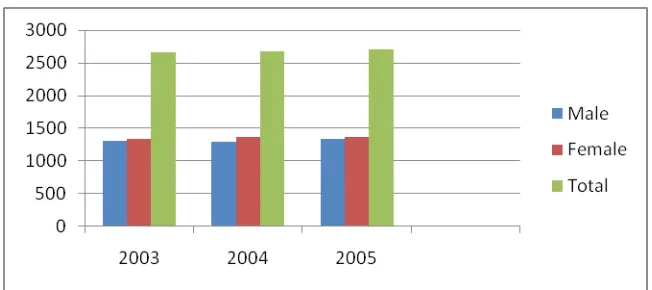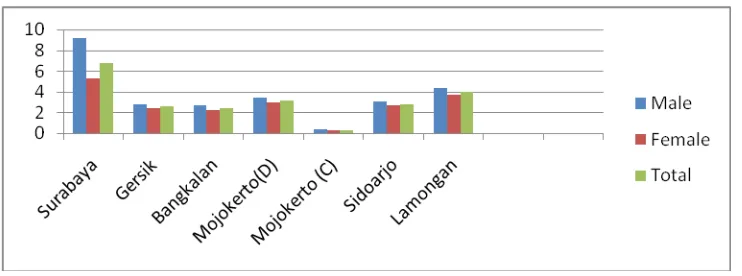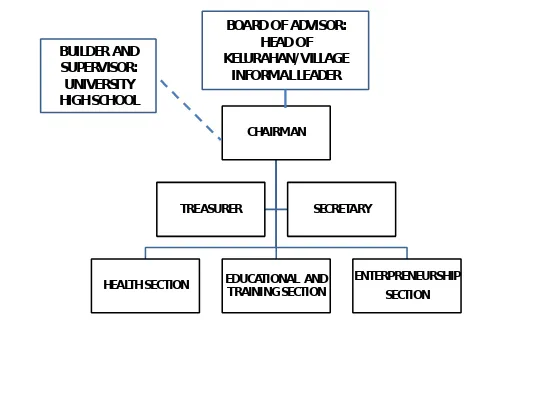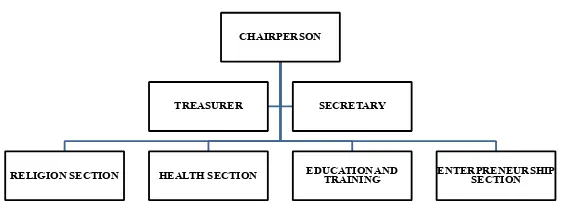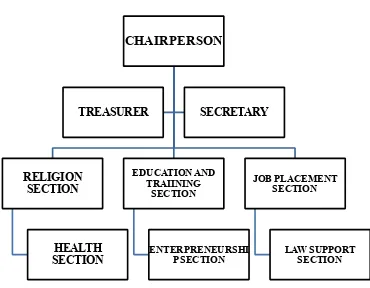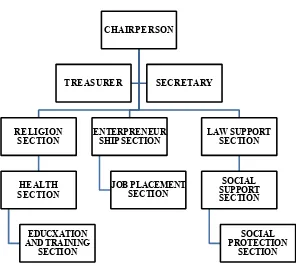A STRATEGIC ACTION FOR OVERCOMING THE ELDERLY
IN CITY OF SURABAYA THROUGH FAMILY EMPOWERMENT POST
By :
Kuntoro, MD, MPH, DrPH
Airlangga University School of Public Health Sunarjo,MD, MS,MSc, PhD
Airlangga University School of Medicine Sri Setijani,MD
Department of Health City of Surabaya Haryono Suyono, MA, PhD
Damandiri Foundation
Abstract
The increase number of elderly results in various problems related to elderly life physically, mentally and socially. Protecting the elderly against the effect of the problems legally is done by issueing the Law, Governmental Regulation,Regional Regulation about the elderly welfare.
Various strategic actions for overcoming the elderly problems are presented, There are three community-based organization are presented. These a Posdaya, Posdayandu, and Gerbangmas. There are three types of elderly Posdaya are proposed, Basic, Intermediate, and Advanced Elderly Posdaya. In this Posdaya the programs that are relevant to the enhancement of human development index and the regional regulation are proposed.These are health, education and training, entreneurship, and religion, mental-spiritual services in Basic Elderly Posyandu. The program can be added as the type of Elderly Posdaya changes to be Intermediate and Advanced Elderly Posdaya based evaluation.
It is recommended to establish a basic type in the beginning in the small-scale regions. After evaluation, the same type can be replicated to other regions or the type can be enhanced to be higher type.
I
INTRODUCTION
City of Surabaya has been participating in national development over years. This results in rapid growth of the city particularly in building and construction, trade and industry, marine, and education. Consequently, many people from districts around Surabaya such as Gresik, Bangkalan, Mojokerto. Sidoarjo and Lamongan enter Surabaya for seeking the job and doing small scale business. They can be temporary residents or commuters. This is a migration problem in City of Surabaya.
The success of national family planning and health program results in declining fertility and mortality. Consequently, population composition in City of Surabaya changes significantly. It shows low percentage of people under 15 years old, high percentage of people 15 to 59 years old, and the growing percentage of people 60 and older. The latter is the group called the elderly ( in Indonesian called “LANSIA” or “PENDUDUK LANJUT USIA”).
As the people of City of Surabaya are more educated, easy to access information technology and communication, they tend to change their lifestyles and traditional cultures to be more modernized community. Consequently, there would be a change of family life particularly among them who have elderly in their families. As the children are going to school, the parents are going to jobs, elderly are living alone at homes. The problem exists when they are non-potential elderly. These are the elderly who do not have capability to work so that their lives rely on other people. The two of other types of elderly are neglected elderly and potential elderly.
II
DEMOGRAPHIC FEATURES OF CITY OF SURABAYA
The following figure shows the population projection of Indonesia according to the censuses of the year 1970 and 2000.
Figure 1 Indonesia Population Projection in Millions (Source : Suyono, 2006)
Figure 1 shows that the population of elderly of 65+ years old tend to increase from 1970 to 2025. There will be a problem of elderly in national level.
The following figure shows the population projection of East Java Province according to the census of the year 2000.
Figure 2 East Java Population Projection in Thousands (Source : Suyono, 2006)
Figure 3 Population of City of Surabaya in Thousands (Source : Suyono, 2006)
Figure 3 shows that population of City of Surabaya tend to increase gradually from 2003 to 2005.
Figure 4 Population of Elderly in City of Surabaya (Source : Suyono, 2006)
Figure 4 shows that population of elderly tends to increase from 2003 to 2005. Moreover, female elderly increase higher than male elderly.
Figure 5 Percentages of Elderly in City of Surabaya and Vicinity (Source : Yayasan Gerontologi Abiyoso, 2006)
Figure 5 explains that City of Surabaya shows the highest percentage of elderly in both sexes and total. The second highest percentage occurs in District of Lamongan. City of Surabaya shows the greatest difference of percentage between male and female.
III LEGAL ASPECT OF ELDERLY
The national government appreciates highly the existence of elderly. Elderly have the important role in the national development in the past. The success of the national development today results from the contribution of elderly when they were in productive age. Legally, elderly are protected by The Law or “Undang-Undang” No 13/1998 about Elderly welfare, Government Regulation or “Peraturan Pemerintah “ No 43/2004 about enhancing the social welfare of elderly, and President Decision or “Keputusan Presiden” No 52/2004 about the establishment of Elderly National Commission or “ Komnas Lansia “. This commission is responsible to assist The President in coordinating the effort to enhance elderly welfare and to recommend the President in constructing the policy related to effort to enhance elderly welfare.
in the regions. East Java Province where City of Surabaya is located is the first province that issues The Regional Regulation No 5/2007 that is effective since 31 July 2007. Elderly Regional Commission of East Java or “Komda Lansia Jawa Timur” has the important role in assisting and recommending the Governor in refining the concept of regional regulation. This commission was establihed in 5 February 2007 around five months before issuing that regulation.
According to regional regulation mentioned above, elderly are categorized into first, the potential elderly who have capability to work/to do activities that produce goods and/or services. Second, the non-potential elderly who do not have capability to work so that their lives rely on other people. Third, the neglected elderly who are due to various causes they can not fulfill their essential needs spiritually, physically, and socially.
Moreover, according to that regulation, the enhancement of elderly welfare includes first, religion, mental-spiritual services, second, health services, third, job opportunity services, fourth, education and training services, fifth, public facility services, sixth, legal services, seventh, social support, and eighth social protection.
The problem of elderly should be solved by all components in the region that include regional government, community, and private sectors such as business. The community institutions that accommodate elderly activities are Elderly Post or “Karang Werda”, Elderly Integrated Services Post or “Posyandu Lansia” , and Elderly Nursing Homes or “Panti Werda” particularly for the non-potential elderly.
IV INTRODUCING POSDAYA
Historical background can be traced back 25 years ago when Haryono Suyono was Head of National Family Planning Coordination Board and Suwardjono Suryanoingrat was Minister of Health developed an integrated services post or “Posyandu “ in 29 Juni 1983. In the beginning, Posyandu implemented the eight functions of family such as religion function, cultural function, affection function, family protection and care function, health care function, educational function, enterpreneurship function, and environmental sustainability function. In the course of time, Posyandu emphasized family planning and health until economic crisis prevailed in Indonesia in 1997. Many Posyandus were dormant and left by their cadres. In 2005 the President ordered to revitalize Posyandu. However, Posyandus are still bringing the old fashion.
Two strategic issues related to the problem of low human development index and how to achieve Millenium Development Goals in the year of 2015 inspires Haryono Suyono to develop Posdaya, a comprehensive community participation in a comprehensive community organization in order to support the Government in all levels to enhance human development index and to achieve Millenium Development Goals. In Posdaya, eight family function is revitalized and adapted to current issue and local condition.
It is introduced several community-based organizations as comparison. These are Posdaya, Posdayandu and Gerbang Mas. When Posdaya can be considered as generic name of community-based organization, the two others are the specific forms that rely on the historical back ground and local conditions.
A. POSDAYA
is an educational component of human development. Teachers and students of High School can participate in Posdaya development.
Each posdaya operates in Kelurahan or Village level. Basically, each Posdaya may have organizational structure as follows
CHAIRMAN
HEALTH SECTION EDUCATIONAL AND TRAINING SECTION ENTERPRENEURSHIP SECTION
Posdaya is developed closed to the high school when it is school-based. A high school teacher can involve in that structure to be a chairman, treasurer, secretary, or head of educational section depending on the consensus during mini-workshop of Posdaya development. A midwife or a nurse who lives in Kelurahan or Village can also involve in Posdaya as well as teacher. The core programs include health, education, enterpreneurship. Those are the components of human development index. A high school student can participate in Posdaya by learning the community dynamics. The high school students are part of critical mass who can learn how to create the idea for solving the problem in the community. This valuable experience is expected to change the attitude of paying attention to poor people and to build social solidarity.
Posdayas. The chairman and staff of Posdaya should learn about the failure of Posyandu Program in the past. The program to be implemented should be based on current issue and local condition. A sustainable Posdaya can be maintained when the people in the community have strong commitment to Posdaya. Chairman and staff should build the trust, honesty, patience. non-material resources idea. An idea of learning organization that has five components such as mental model, personal mastery, system thinking, shared vision and team learning can be used to strengthen commitment and team work.
B. POSDAYANDU
In District of Jembrana, Province of Bali there is a kind of Posdaya called “ Posdayandu “ or Comprehensive Services and Empowerment Post. A Posdayandu operates in Banjar level. The number of Banjar in this District is 214. A Banjar is a kind of religious-cultural-based organization that has existed since the history of Balinese in Province of Bali. Hence, all Posdayandu serve all people in District of Jembrana (Pemkab Jembrana, 2008).
Development of Mosque-based Posdaya is welcomed and appreciated by District Government although Moslem are minority in this District. This is a practice of Religion tolerance. These special Posdayas emphasize three programs health, education, and enterpreneurship. However, today enterpreneurship program is implemented first in order to motivate the people’ spirit since it has direct effect on their daily lives. In this program, various training accompanied by early capital support and guidance are implemented. Furthermore, they run small scale business and they may get profit (Pemkab Jembrana, 2008).
Indonesia and other countries plan to achieve MDGs in 2015 based on global agreement that was signed by the Heads of The States in UN Assemby in 2000. Amazingly, Bupati of Jembrana plans to achieve MDGs in 2010. He mobilizes 170 community empowerment personnel who safeguard poor people intensively through 214 Posdayandus that spread in all villages. Posdayandu provides various information and technical assistance needed for minimizing poverty. All activity programs written in Expenditure and Revenue District Budget have to lean on minimizing poverty, unemployment and people economic improvement (Pemkab Jembrana, 2008)
C. GERBANGMAS
Gerbangmas or “Gerakan Membangun Masyarakat Sehat “ or “Movement to Develop Healthy Community “ is the idea of “Bupati” or Head of District Lumajang , East Java Province. It is developed to achieve Healthy Indonesia in 2010 and Qualified Family in 2012 in which all people are kept and taken care their health (Pemkab Lumajang, 2008).
Gerbangmas is implemented by enhancing the role of the existing Posyandu. Gerbangmas is the center for education and training of community health. Gerbangmas motivates the potencies of community, private sector, NGO, Inter-sectors within District Government , and all community components simultaneously enhance health status and community welfare (Pemkab Lumajang, 2008)
expected outcome is to be healthy Lumajang in 2010 and qualified family in 2012 (Pemkab Lumajang, 2008).
In the level of Posyandu, a cadre is a component that executes the program assisted by community leader, religion leader, youths and other components. The number of Posyandu in each village varies from one to two depending on demand of people in the community and the local conditions. In the level of village there is Village Team headed by the wife of “Kepala Desa” or Head of Village as chairperson of Motivator Team of Family Welfare Building, while Kepala Desa or Head of Village is person in charge. In the level of Subdistrict, there is Subdistrict Team headed by the wife of Head of Subdistrict as chairperson of Motivator Team of Family Welfare Building, while Head of Subditrict is person in charge. In the level of District, there is District Team headed by the wife of “Bupati “ or Head of District as chairperson of Motivator Team of Family Welfare Building, while Bupati or Head of District is person in charge (Pemkab Lumajang, 2008)
V THE PROGRAM FOR ELDERLY
There are various community organizations concern about elderly problem. There is a Karang Werda or Elderly Post. This term only exists in East Java Province. It is developed in a village or Kelurahan level. It is the place to accommodate elderly activities. It is a community social organization as partner of Village or Kelurahan Governance in empowering elderly. In subdistrict level, a number of Karang Werdas is coordinated by Cooperation Forum of Karang Werda under Head of the Subdistrict. The potential and non-potential elderly are expected to interact in Karang Werda. While the neglected elderly are organized by Panti Werda or Elderly Nursing Homes. This organization is under jurisdiction of the Governor through Department of Social East Java Province. The neglected elderly who admit elderly Nursing Homes should be recommended by District/City Government and approved by Head of Department of Social East Java Province. Since the number of elderly Nursing Homes are limited, the Government let community and private sectors construct elderly Nursing Homes.
incurable diseases through Elderly Medical Committee; developing Posyandu Lansia or elderly Integrated Services Posts and the Decent Elderly PHCs and Out-patient and In-patient Clinic for elderly in Hospitals.
Education and training services for elderly is designed to enhance knowledge, expertise, skill, capability and experience of the potential elderly appropriate to their own potencies. Education and training can be done formally and informally that are relevant to the interest and talent of elderly.
Social support for elderly is designed to support the potential elderly who are poor in order to fulfill their requirements and enhance their level of welfare. Temporarily social support includes materials, finance, service facility and information. It is given to elderly who have been selected and received social guidance. The next step, elderly are expected to create and develop small scale business in oder to enhance income and self-supporting; to obtain amenity in business opportunity. Economically productive business and common business group are the forms of social support.
Social protection for elderly is designed to serve the non-potential elderly in order to protect against various risks such as physical, mental, and social disturbances and threats that could result in disability. The forms of social protection are consorting elderly socially, providing welfare consultation centers, providing social security scheme, providing funeral.
VI POSDAYA AS AN ALTERNATIVE SOLUTION FOR ELDERLY
problem. The mixture of the potential elderly and the youth is the good learning process where they can share the experience each other, they can build shared vision for the organization to be developed, they work as good team work.
A Basic Type of elderly Posdaya
The objective of this type is to enhance the role of elderly in supporting the Government to enhance human development index. This type should have at least three sections that represent the three components of human development index. These are Health , Education and Training, and Enterpreneurship Sections and one section to accommodate Regional regulation No 5/2007, Religion Section that serves elderly concerning the religion, mental and spiritual. By practicing the religion intensively, elderly are expected to have strong mental and spiritual. Consequently they consciously support elderly Posdaya program.
Health Section makes coordination with PHCs. The programs include first, health promotion and prevention through enlightment, leaflet, and discussion; second, disease screening and monitoring through medical check-up and medical evaluation periodically.
Education and Training Section make coordination with participating universities and high schools. The programs include first, strengthening the existing potency (expertise, experience), and second, enhancing knowledge and skill of certain interest (handicraft, traditional music, traditional song).
Enterpreneurship Section make coordination with business worlds that pay attention to elderly. The programs include first clerkship in business world, second, developing business plan for elderly, third, proposing bank loan for elderly for small scale business.
CHAIRPERSON
RELIGION SECTION HEALTH SECTION EDUCATION AND TRAINING ENTERPRENEURSHIP SECTION TREASURER SECRETARY
Figure 7 Structure of Basic Type of elderly Posdaya
The program should be evaluated each year. Evaluation of performance can be done by Evaluation form that includes the number of elderly who are involved to each program in each section compared to the number of elderly in the target area, the number of lecturers, teachers, students who involve Posdaya compared to the number of lecturers, teachers, students, the number of business world that involve Posdaya compared to the number of business world in target area. It is recommended that evaluation will be done by participating universities and high schools. These institution will decide whether elderly Posdaya can be expanded to be the Intermediate type or not.
B Intermediate Type of elderly Posdaya
Law Support Section makes coordination with Law Support Board in participating universities that have School of Law or other Law Support Boards. The programs of Law Support Section include first, enlightment about the Law including law related to elderly, second, advocating elderly who have law problem (divorce, heritage). The following figure describes the organizational structure of Intermediate Type of elderly Posdaya.
CHAIRPERSON
Figure 8 Structure of Intermediate Type of elderly Posdaya
C The Advanced Type of elderly Posdaya
Basically this type is similar to Intermediate Type and two more section are added, Social Support Section and Social Protection Section. This type fulfills the expectation of Regional Regulation No 5/2007.
Figure 9 Structure of Advanced Type of elderly Posdaya
Social Protection Section makes coordination with District/City/Provincial Social Offices and other donor agencies that provide social security program the non-potential elderly. The programs of Social Protection Section include first, exploring possible donor agencies, second. Coordinating with Social Office in the District/City/Provincial level.
Evaluation should be done and is the same as the previous type. Additional evaluation includes the number of the potential elderly who receive social support compared to the number of the potential elderly in the target area, and the number of the non-potential elderly who receive social protection compared to the number of non-potentialm elderly in the cacthment area.
VII CONCLUSION AND RECOMMENDATION
First, the number of elderly in City of Surabaya tend to increase, The number of elderly in this city is the highest among seven districts and cities called “GERBANGKERTASUSILO or Gresik, Bangkalan, Mojokerto, City of Mojokerto, City of Surabaya, Sidoarjo and Lamongan “
Second, the Government has the strong commitment to enhance elderly welfare by issuing the Law, Government Regulation, Regional Regulation.
Third, Posdaya is the alternative community organization for overcoming elderly problem
Fourth, Basic, Intermediate, and Advanced Elderly Posdaya are recommended
Fifth, Posdaya should accommodate local conditions that include social, cultural, economic aspects.
Reference :
East Java Social Office. 2008. Elderly National Commision. Surabaya. Dinsos Jatim
East Java Social Office. 2008. The Regional Regulation No.5/2007.Surabaya. Dinsos Jatim
Kuntoro. 2007. Posdaya As Complement of Aware Village- Workshop of Universities Networks and Indonesian Institute for Human Development . Surabaya. IIHD
Pemkab Jembrana http://www.jembranakab.go.id/m-kependudukan.php downloaded in 15 October 2008
Pemkab Lumajang http://www.lumajang.go.id/gerbang.php?tema=pengelolaan downloaded in 15 October 2008
Suyono, H. 2006. Elderly care in Surabaya – A Case Study of Best Practices In Care for Old Elderly. Jakarta. Dana Sejahtera Mandiri Foundation.
Suyono, H. 2005. Population, Health, Education Dynamics in the City of Surabaya, Indonesia: Towards MDGs 2015.Jakarta. Dana Sejahtera Mandiri Foundation.

